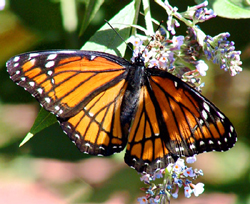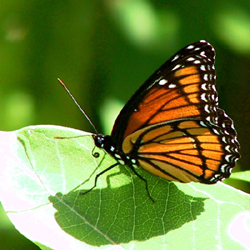Find a Butterfly
Viceroy
Limenitis archippus
Named
Cramer, 1776

Identification
Wingspan: 2 5/8 3". Boldly patterned in rich orange with black veins, the Viceroy is often confused with the Monarch, but may be separated by its smaller size, deeper orange coloration, black line across the hindwing, and unMonarch like flapping and gliding flight pattern.
Distribution
Northwest Territories east to Newfoundland and south (east of the Sierra Nevadas and Cascades) to Mexico and the Gulf states. In New England, absent only from northernmost Maine.
Status in Massachusetts
The Viceroy, judging by historical data, has always been one of our commoner butterflies. Scudder called it abundant in southern New England, less so in more northern districts. According to Farquhar it was generally common throughout New England. In Massachusetts today, the species may be considered common and conspicuous throughout most of the state. It is apparently very scarce on Cape Cod and the Islands; during the Atlas, we had but two regional records. This is not easily explained, as there are adequate larval food sources available in the area. In adjacent areas of southeastern Massachusetts, it is locally abundant. Maximum: 41, on 26 July 1987, New Bedford (Bristol Co. ) and also 41, on 31 July 1993, Easton (Bristol Co.).

Flight Period in Massachusetts
Late May to early October, with peak numbers in mid June and late July/early August. Extreme dates: 17 May 1991, BMBS (Worcester Co.), T. Dodd, and 30 September 1994, Sudbury (Middlesex Co.), T. Dodd.
Larval Food Plants
Preferred food plants are willows, including Pussy Willow, (Salix discolor) and Black Willow, (Salix nigra), and aspens, several of which are common and widespread in Massachusetts. Cherry and apple are among other cited food sources.
Adult Food sources
Opler and Krizek (1984) note that first brood Viceroys seldom visit flowers, taking food and moisture from dung, carrion, aphid honeydew, and puddles. In Massachusetts, early season Viceroys have been seen at Arrowwood, brambles, and Grey-stemmed Dogwood. Mid and late summer flowering plants, including mints, asters, goldenrods, milkweed, and Joe Pye Weed attract later flights. Twenty-one nectaring plants were recorded during the Atlas period.

Habitat
Viceroys inhabit a variety of open habitats, including roadsides, streamsides, and meadows where the larval food plants grow.
Life Cycle
EGG: pale green, becoming gray; dome shaped, surface covered with hexagonal cells, a short hair arising from each angle. OVIPOSITION: Eggs laid singly, typically at tip of host leaf and usually on the upperside. LARVA: Greenish brown, with white markings on back and sides; pair of antenna like structures arising from front end of thorax; foreparts often strongly arched. CHRYSALIS: Dark brown, with whitish abdomen and projecting bump in back. OVERWINTERING STAGE: Larvae.
In Massachusetts, partially grown Viceroy larvae emerge in late spring, feed on young willow and aspen leaves, and after seven to ten days in the chrysalis, fly in numbers in June. The second brood peaks about six weeks later, in late July, and at least a portion of the eggs laid by this brood develop to the imago, as fresh adults may be found flying and mating well into September. This third brood is relatively small in number and suggests that many of the late summer, second brood larvae (and all those of the third generation) suspend feeding, usually during the second or third instar, and construct a winter resting place for themselves. The curious hibernaculum, which the caterpillar constructs from the leaf of a sapling aspen or willow, is similar to that of the Red spotted Purple and White Admiral. Silking the leaf stalk to a twig to prevent it from later falling to the ground, the half grown larva consumes the terminal end of the leaf, excepting the midrib, and from the remaining basal portion fashions a tunnel by silking the leaf edges together. Here it passes the better part of three seasons, to emerge with the new leaves the following spring.
Male Viceroys habitually patrol back and forth in low flight over a favored patch, frequently returning to the same perch.
Perhaps no species of butterfly has developed a more complete system of mimetic survival than has the Viceroy. As an egg, it resembles a tiny plant gall; as both larva and pupa it bears a striking resemblance to a bird dropping; as an adult it is shunned as food by birds because of its similarity to the Monarch (see Notes).
Notes
The Viceroy, long considered a palatable mimic of the unpalatable milkweed butterflies, the Monarch and the Queen, has recently been shown to be unpalatable itself (Ritland and Brower, 1991). In fact, experiments have shown the Viceroy to be as unpalatable as the Monarch and significantly less palatable than the Queen. This implies that the Viceroy is not a batesian mimic (unpalatable model, palatable mimic), but rather a mullerian co mimic (multiple unpalatable co models) of the Monarch and Queen. Some viceroys synthesize their own toxins.
Opler and Krizek (1984) state that female Viceroys lay eggs during afternoon hours, between 1:00 and 5:00. During the Atlas project, Tom Dodd observed Viceroys ovipositing on nine occasions, seven before 1:00 p.m.. Dodd also discovered 175 hibernacula on 1‘ 3‘ willow and aspen saplings in a small area at the Wachusett Reservoir, Worcester County. One quarter, forty four, showed outward signs of parasitism.
Account Author
Brian Cassie



